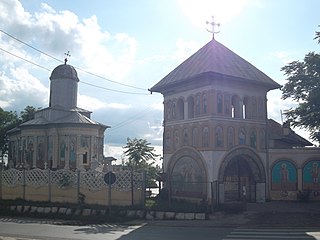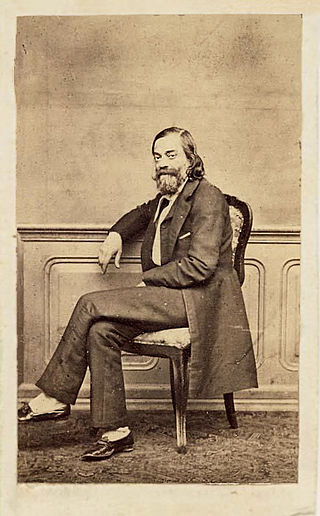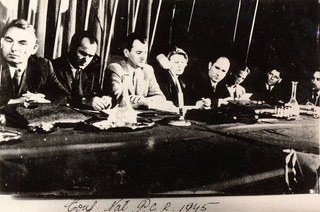| |||||
| Decades: | |||||
|---|---|---|---|---|---|
| See also: | |||||
Events from the year 1882 in Romania. The year saw the departure of the Thetis, carrying Romanian Jews to Palestine.
| |||||
| Decades: | |||||
|---|---|---|---|---|---|
| See also: | |||||
Events from the year 1882 in Romania. The year saw the departure of the Thetis, carrying Romanian Jews to Palestine.

The National Peasants' Party was an agrarian political party in the Kingdom of Romania. It was formed in 1926 through the fusion of the Romanian National Party (PNR), a conservative-regionalist group centred on Transylvania, and the Peasants' Party (PȚ), which had coalesced the left-leaning agrarian movement in the Old Kingdom and Bessarabia. The definitive PNR–PȚ merger came after a decade-long rapprochement, producing a credible contender to the dominant National Liberal Party (PNL). National Peasantists agreed on the concept of a "peasant state", which defended smallholding against state capitalism or state socialism, proposing voluntary cooperative farming as the basis for economic policy. Peasants were seen as the first defence of Romanian nationalism and of the country's monarchic regime, sometimes within a system of social corporatism. Regionally, the party expressed sympathy for Balkan federalism and rallied with the International Agrarian Bureau; internally, it championed administrative decentralization and respect for minority rights, as well as, briefly, republicanism. It remained factionalized on mainly ideological grounds, leading to a series of defections.

Lupu Coci, known as Vasile Lupu, was a Voivode of Moldavia of Albanian and Greek origin between 1634 and 1653. Lupu had secured the Moldavian throne in 1634 after a series of complicated intrigues and managed to hold it for twenty years. Vasile was a capable administrator and a brilliant financier and was soon almost the richest man in the Christian East. His gifts to Ottoman leaders kept him on good terms with the Ottoman authorities.

Jilava is a commune in Ilfov County, Muntenia, Romania, near Bucharest. It is composed of a single village, Jilava.

Ion Mihalache was a Romanian agrarian politician, the founder and leader of the Peasants' Party (PȚ) and a main figure of its successor, the National Peasants' Party (PNȚ).

The Sighet Prison, located in the city of Sighetu Marmației, Maramureș County, Romania, was used by Romania to hold criminals, prisoners of war, and political prisoners. It is now the site of the Sighet Memorial Museum, part of the Memorial of the Victims of Communism.

Constantin Alexandru Rosetti was a Romanian literary and political leader, born in Bucharest into the princely Rosetti family.

Max Carol Auschnitt, also known as Ausschnitt, Auschnit or Aușnit, was a Romanian businessman and political figure, one of his country's most prominent industrialists during the interwar period. Born to Ukrainian Jewish immigrants, he spent much of his youth abroad, returning in the 1910s to set up business as an importer of sheet iron, greatly expanding his father's fortune after World War I. Auschnitt was caretaker, and from 1929 managing director, of the Iron Domains and Factory (UDR) of Reșița, as well as founder of Titan-Nădrag-Călan (TNC), regional partner of Vickers-Armstrongs, and investor in many other fields. Primarily known as the "iron king" of Greater Romania, he had a business connection, and later a consuming rivalry, with manufacturer Nicolae Malaxa. The two were associate owners of Creditanstalt, which established their presence in Europe.

Nicolae Ciupercă was a Romanian general, born in Râmnicu Sărat. He served during World War I and World War II under the command of Alexandru Averescu and then Ion Antonescu, but would retire from a military life in 1941 over strategy disagreements with Antonescu. He also served as Minister of National Defense in 1938–1939.

Gherman Vasile Pântea was a Bessarabian-born soldier, civil servant and political figure, active in the Russian Empire and Romania. As an officer of the Imperial Russian Army during most of World War I, he helped organize the committees of Bessarabian soldiers, oscillating between loyalty to the Russian Provisional Government and the cause of Bessarabian emancipation. Pântea was subsequently Military Director of the Moldavian Democratic Republic, answering to President Ion Inculeț. He personally created a Bessarabian defense force, tasked with combating Bolshevik subversion and Russian intimidation, but also braced for defeat after the October Revolution.

Victor Gomoiu was a Romanian surgeon, anatomist, folklorist and medical historian, who served as Minister of Health and Social Protection in 1940. Noted before 1910 for his work in descriptive surgery and pathology, focusing on the treatment of tuberculosis, genital diseases and tumors, he soon became one of the main contributors to medical historiography and bibliography. He founded several hospitals and edited medical journals, setting up a collection of medical instruments which became the basis of a national museum in Craiova. He became a professor at the University of Bucharest, an expert for the League of Nations, and, after distinguished service in World War I, a recipient of the Legion of Honor; additionally, he served for 22 years as president of the International Society for the History of Medicine, of which his wife Viorica was also an active member.

The Paharnic was a historical Romanian rank, one of the non-hereditary positions ascribed to the boyar aristocracy in Moldavia and Wallachia. It was the local equivalent of a cup-bearer or cześnik, originally centered on pouring and obtaining wine for the court of Moldavian and Wallachian Princes. With time, it became a major administrative office and, in Wallachia, also had a lesser military function. The retinue of such boyars, usually called Păhărnicei, was in both countries also a private army.

Events from the year 1945 in Romania. The year saw the end of Romania's involvement in World War II and the foundation of the pro-Communist government of Petru Groza.
Events from the year 1947 in Romania. The year saw the abdication of Michael I of Romania and foundation of the Romanian People's Republic.
Events from the year 1946 in Romania. The year started with the end of the royal strike and ended with the Romanian Communist Party win the first election following the introduction of women's suffrage.

Events from the year 1950 in Romania. The year saw Romania build relationships with other Communist states, including China and East Germany.
Events from the year 1963 in Romania. The year saw the continued de-satellization of Communist Romania.
Events from the year 1922 in Romania. The year saw the Dealul Spirii Trial and the crowning of King Ferdinand.

Jilava Prison is a prison located in Jilava, a village south of Bucharest, Romania.